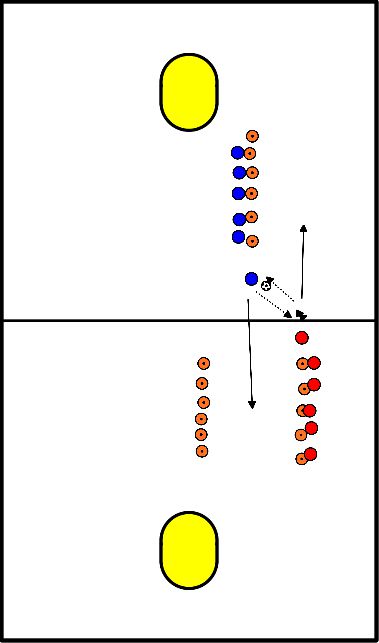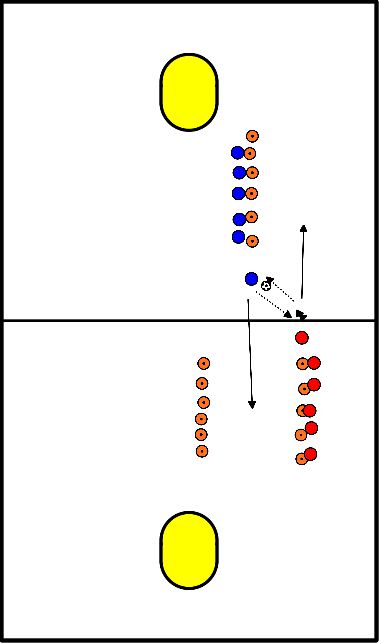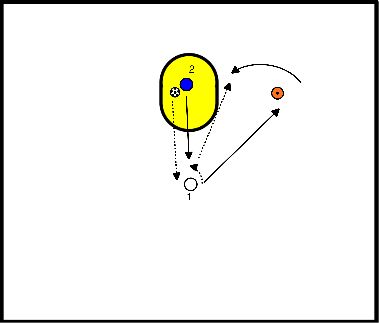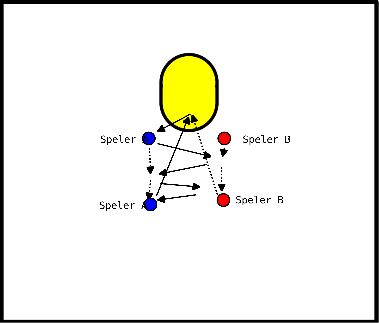Korfball drills for technique passing / attack
- 4 v 4 on badminton court with post in middle
- Practice the passing exercise but now have choice of which way, still need to make contact first
- If you have a shot, take it, if not pass to someone else, include long diagonal, emphasise contact first
- If there is a shot going up and you are nearest, get to post to collect, shooter to follow shot in
- After a shot, reset and go again, swap roles after three shots or five minutes which ever comes first
- Timing of pass - do not go straight to the end, need to build this up one piece at a time, several moving parts to master individually
- Make contact, step out, pass into space, receiver watches and moves to receive at last moment. Defenders remain static, but arms in motion. Reset and pass back the other way. After two minutes swap attackers and defenders, Are you getting better at timing reception of pass?
- Repeat exercise but now defenders lose use of arms but can move bodies to make this more of a challenge, same reset and repeat and change after two minutes
- Final variation, defenders now try to stop pass and stop reception, same reset and repeat and change after two minutes
- This exercise is designed to let the players choose for themselves what they want to improve on.
- Which (improvement) goal, which they have set for themselves, do they want to improve here.
- As a trainer you can steer this by guiding the choice.
- For example: the exercise must have something to do with passing/shooting/attacking/looking etc.
- Players stand in line in front of the basket.
- Player 1 throws the ball to player 2 and player 1 runs after it halfway and inside.
- Player 2 throws the ball at the moment he/she thinks the other player can make a good run through.
- Player 1 finishes it. (and start again at step 1)
- Players stand next to each other.
- The ball is thrown to player 2 and player 1 runs after it until halfway and inside.
- Player 2 throws the ball at the moment he/she thinks the other player can make a good run through.
- Player 1 finishes it.
- Make two rows at 10 metres opposite each other and about 3 metres apart.
- The players face each other one by one.
- Face each other with both hands and do not drop the ball.
- Make a series as high as possible in 1 minute.
- Play with the outer hand on the outer hand of your opponent, with one hand throw and catch (right), make a series as high as possible without dropping the ball.
- Play with the outside hand on the outside hand of your opponent, with one hand throw and catch (left), make a series as high as possible without dropping the ball.
- Run into each other, jump and catch and throw the ball in the air with two hands.

- Make two rows at 10 metres opposite each other and about 3 metres apart.
- The players face each other one by one.
- Face each other with both hands and do not drop the ball.
- Make a series as high as possible in 1 minute.
- Play with the outer hand on the outer hand of your opponent, with one hand throw and catch (right), make a series as high as possible without dropping the ball.
- Play with the outside hand on the outside hand of your opponent, with one hand throw and catch (left), make a series as high as possible without dropping the ball.
- Run into each other, jump and catch and throw the ball with two hands in the jump.

Training on tight passing.
- 2 players start at about 2 metres from each other You can increase/decrease the distance over time or depending on the variation you do.
- Passes must be hard!
- Make sure that you don't throw hard just for the sake of throwing hard, but that you throw hard to get the ball to the team-mate quickly and tightly.
- Keep reminding them of this constantly.
- Passes should also be tight.
- No "piss bows". These passes are slow and easy to intercept.
- When catching with one hand, make sure you move with the hand and if necessary step with the corresponding leg
Variation 1
- Player 1 passes with his right hand to player 2's left hand.
- Player 2 takes over and passes right back to player 1.
- After one minute both players change their throwing and catching hand.
- Repeat this at larger and larger distances.
Variant 2
- Player 1 passes right to player 2's left hand.
- Player 2 passes back with his left hand to the right hand of player 1.
- After one minute both players change their throwing and catching hand.
- Repeat this at larger and larger distances.
Variant 3 - with movement left-right
- Player 1 has the ball.
- Player 2 moves to the left or right.
- Player 1 passes to outside hand of player 2.
- Player 2 passes back with his outside hand.
- After one minute, the players change positions. (Player 1 moves left/right. Player 2 passes to).
- Repeat at increasing distances.
Variant 4 - deep line
- Player 1 has the ball.
- Player 2 moves towards player 1 from the side.
- Player 2 puts his foot across and runs a deep line away from player 1.
- Player 1 passes with a small arc (but still tight!) to player 2.
- After one minute the players change function (player 1 starts running, player 2 passes to him).
Doubles:
- Number 1 in front of the basket (6 meters),
- Number 2 with ball under the basket. 1 pawn left or right of the basket at about 4 to 6 metres.
- Number 2 throws the ball to number 1.
- Number 1 puts the ball on the ground and runs to the pawn and around it towards the basket.
- In the meantime, number 1 runs to the ball on the ground and passes it to number 2 for a deep pass.
- This is repeated until 8 balls have been made.
- The pace is important:
- The runners may not stand still, but you may not run too slowly.
- The timing of the passing must be correct.

- Player A starts with the ball 2.5 meters diagonally in front of the post. Player B also stands 2.5 meters diagonally in front of the post.
- Player A throws the ball to player B and player B throws it back. Thus they bring the ball up to about 8 meters in front of the post.
- From there, player B starts for a through ball from the space indicated by player A.
- However, instead of player B taking the through ball, it now enters the declarer and player A comes in for a clearance ball. Player B catches the ball.
A variation on this:
Only throw the ball when player B runs next to/behind the basket and player B immediately makes a shot. Player A immediately runs in to catch the ball.
Only throw the ball when player B runs next to/behind the basket and player B immediately makes a shot. Player A immediately runs in to catch the ball.
There are more variations on this, such as:
- Most goals in a time frame of, say, 10 minutes
- Who scores 10 goals first
- Make it more difficult by deducting a point for each ball on the ground.
- Possibly with a 3rd player to rotate and keep a slightly slower pace.

- Make a circle at the level of your head on the wall (with sidewalk chalk)
- Make the circle about the same size as a basket.
- Now stand 3 or 4 meters away from the circle.
- Now throw the ball with your left against the wall and catch it with your right hand.
- Do this for one minute.
- The ball must not bounce on the ground.
- If it is too easy, stand further away or try to throw the ball faster. If the exercise is too difficult, try to catch the ball with two hands, but still throw with one hand
- Or stand a little closer to the wall. (Outdoors exercise)
(3:1) There is play. There are always 4 of the 5 positions filled. So everybody has to keep moving. There are no 3 persons next to each other etc.







